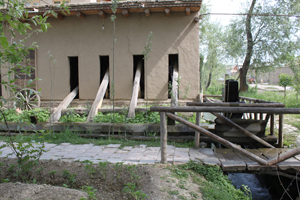 |
| Koni Gil paper mill - a very charming setting |
From Samarkand, papermaking spread to Baghdad, Damascus, and Cairo. By 900 A.D. bookshops and even public lending libraries existed in the Arab world. Paper entered Europe in the 12th century, after North African Moors conquered Spain and Portugal carrying the process with them.
 |
| Preparing mulberry branches for soaking |
Fast forward to the mid-1990s, when Uzbek miniature painters faced a critical shortage of suitable paper for their work: local artisan Zarif Muhtarov resolved to revive handmade paper.
With the support of UNESCO and JICA, a suitable site in the village of Koni Gil,10 kms from Samarkand, was identified. A traditional water mill was constructed, fed by the clear waters of the Siob river. Mulberry bark provides the fibre, an ingenious system of simple water-driven machinery is used to pound the stripped bark into the desired softness and a dedicated band of apprentices works with Usto (master) Muhtarov to create sheets of hand-made paper. Once again Samarkand paper is being produced using traditional methods.
 |
| Finished paper masks |
Demand for the paper is growing, particularly in the field of restoration of Korans. Usto Muhtarov and his team also experiment with new products that will appeal to tourists who visit. As well as beautiful cards painted with suzani designs, I bought adorable bookmarks there this year, in the shape of Uzbek women with round non (bread) piled on their heads.
On Uzbek Journeys tours you will visit Koni Gil, view the production process and enjoy a green tea in the shaded grounds of this lovely workshop.
Related post: Travelling the Great Silk Road to Canberra, Australia